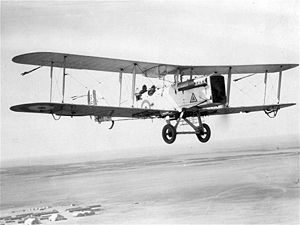Polikarpov R-2
| DH.9A | |
|---|---|
 |
|
| Airco D.H.9A | |
| Role | Light bomber/General purpose |
| Manufacturer | Airco |
| First flight | March 1918 |
| Introduction | 1918 |
| Retired | 1931 |
| Primary user | Royal Air Force |
| Number built | 1,997 |
| Developed from | Airco DH.9 |
| Variants |
Westland Walrus de Havilland DH.15 |
The Airco DH.9A was a British single-engined light bomber designed and first used shortly before the end of the First World War. It was a development of the unsuccessful Airco DH.9 bomber, with a strengthened structure, and crucially, replacing the underpowered and unreliable inline 6 cylinder Siddeley Puma engine of the DH.9 with the American V-12 Liberty engine.
Colloquially known as the "Ninak" (from the phonetic alphabet treatment of designation "nine-A"), it served on in large numbers for the Royal Air Force following the end of the war, both at home and overseas, where it was used for colonial policing in the Middle East, finally being retired in 1931. Over 2,400 examples of an unlicensed version, the Polikarpov R-1, were built in the Soviet Union, the type serving as the standard Soviet light bomber and reconnaissance aircraft through the 1920s.
The DH.9A was planned as an improved version of the existing Airco DH.9. The DH.9 was a disappointment owing to its under performing and unreliable engines, and the DH.9A was to use a more powerful engine to resolve this. As the Rolls-Royce Eagle engine used in the successful DH.4 was unavailable in sufficient quantities, the new 400 hp (298 kW) American Liberty engine was chosen instead.
As Airco was busy developing the Airco DH.10 twin-engined bomber, detailed design was carried out by Westland Aircraft. The DH.9 was fitted with new, longer span wings, and a strengthened fuselage structure.
The first prototype flew in March 1918, powered by a Rolls-Royce Eagle as no Liberty engines were yet available. The prototype proved successful, with the first Liberty-engined DH.9A flying on 19 April 1918, and deliveries to the Royal Air Force starting in June. By the end of the war, a total of 2,250 DH.9As had been ordered, with 885 being built by the end of the year. As it was decided that the DH.9A would be a standard type in the postwar RAF, the majority of outstanding orders were fulfilled, with 1,730 being built under the wartime contracts before production ceased in 1919.
...
Wikipedia
